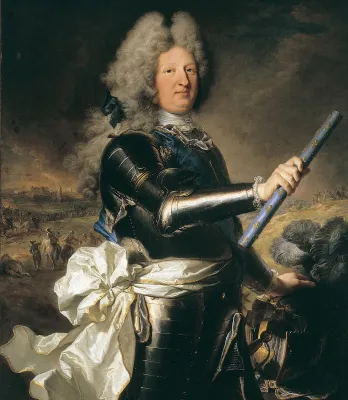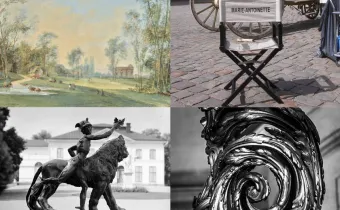“Son of a king, father of a king, but never a king” according to the memoirist Saint-Simon, this major figure of the Grand Siècle who was destined to become the king of France, experienced an unusual fate.
After spending his life subject to the royal authority of his father, he saw his son become the sovereign of Spain, and died at the age of 49 without having reigned himself. As the heir to the throne of France, he received a modern education and went on to became an aesthete and collector. The exhibition will cover every facet of the life of this forgotten prince through 250 works, some of which have never been seen before, assembled from public and private collections in France and abroad, and representing all forms of art. Among the most spectacular pieces are the Chenets de l’Algarde, large bronzes exceptionally loaned by the Wallace Collection in London; gems from the Dauphin’s Treasure held at the Prado Museum and the Louvre; the Fonthill Vase from the National Museum of Ireland in Dublin; and a pair of commodes from the Spanish royal collections, loaned abroad for the very first time. As one of the many French national institutions represented in addition to the Louvre museum, the French National Library is supporting the exhibition with a significant number of loans.
son of a king
The first section of the exhibition will present the family background to the birth of the Grand Dauphin and his childhood, which was shaped by his very special status as heir to the throne.
Monseigneur was born on 1 November 1661 at Fontainebleau. He was the first child of Louis XIV and Maria Theresa of Spain, who married in 1660. This diplomatic union sealed the peace in the kingdom and the birth of a son soon afterwards ensured a dazzling start to the personal reign of Louis XIV after the trauma of the Fronde rebellion which still cast a long shadow.
The Dauphin’s birth was celebrated throughout the kingdom and this child who embodied the future of the dynasty was depicted many times throughout his early childhood.
Louis XIV was keen to provide his son with a better preparation for kingship than he had received himself. The sovereign was therefore personally involved in the choice of tutors for Monseigneur and of the subjects he was taught. The King even wrote his Mémoires to further the Dauphin’s education. Monseigneur was handed over “to the society of men” at the age of seven, and was given what was quite a modern education for princes at that time. He was taught heraldry, French history, religion, sciences (mathematics and geography) by a team of scholars, and notably by Bossuet who became his tutor. This training was accompanied by innovative educational resources: playing cards to help him recognise coats-of-arms and learn the history of the kingdom, illuminated manuscripts of Latin verbs, and even engravings for learning religious history. Many examples will be on display in the exhibition, as well as schoolwork written in the Dauphin’s own hand and some of his artwork.
The exhibition will also present the living environment of the heir to the throne and the sumptuous apartment decorated for the Dauphin at the Tuileries Palace in 1666. Ce décor aujourd’hui disparu réunissait des œuvres d’artistes majeurs du XVIIe siècle tels Charles Le Brun, Jean-Baptiste de Champaigne ou encore Charles II Audran. The surviving paintings, which are now scattered across several European collections, will be reunited for the very first time.
The exhibition will also explore the prince’s training in the strategy and art of war. The son of the king of France had to be ready to assume his future role as commander of the French armies. The Dauphin practised commanding troops in a military fort specially built for him, with his own infantry regiment. He also accompanied Louis XIV during several sieges. His main military feat when he reached adulthood was the capture of the Citadel of Philippsburg in 1668, during the War of the League of Augsburg.
father of a king
The second section of the exhibition will look at the Grand Dauphin’s family, his wife and children.
As set out in the treaty of alliance signed by France and Bavaria in 1670, Monseigneur married Maria Anna of Bavaria, the daughter of the Elector of this powerful Catholic state in the Holy Roman Empire, in 1680. They had three sons: Louis, Duke of Burgundy (1682), Philippe, Duke of Anjou (1683) and Charles, Duke of Berry (1686).
Three years after their wedding, the Dauphine became First Lady of the kingdom when Queen Maria Theresa, the wife of Louis XIV, died. They had initially appeared to be happily married, but the princess died in 1690, laid low with exhaustion after a series of miscarriages.
The exhibition will retrace the unique fate of the Grand Dauphin’s second son, the Duke of Anjou, who became king of Spain under the name Philip V in 1700, thus founding the Spanish branch of the Bourbon dynasty which still reigns today. Charles II, king of Spain and brother of Louis XIV’s wife Queen Maria Theresa, died childless in 1700. He decided to leave the crown and his vast possessions to his great-nephew. Monseigneur therefore became the father of a king.
Never a king
The final section of the exhibition will focus on the Grand Dauphin’s tastes and his lavish collections in particular, which were worthy of a great aesthete.
Louis XIV’s son had a responsibility to uphold his status and his father therefore granted him generous access to the royal collections. He also developed very astute personal tastes and surrounded himself with an extremely wide variety of works of art.
His apartments were adorned with a wealth of masterpieces: paintings, large Florentine bronzes, exquisite marquetry furniture, Chinese porcelain, gemstones and hardstones.
In some respects, Monseigneur’s collections surpassed those of Louis XIV himself. The exhibition will bring together for the first time some of these outstanding pieces (which are now on display at the Prado and Louvre museums, and elsewhere in Europe). This exceptional display will also conjure up the Grand Dauphin’s apartment at Versailles and its legendary mirrored Cabinet des Glaces, which has not survived. The prince displayed some of his treasures in this breathtaking decor.
Monseigneur was also a keen hunter, with a particular fondness for wolf hunting. He enjoyed music and all kinds of shows and performances: theatre, opera, masked balls and equestrian tournaments. These provided opportunities for entertainment with his gradually expanding court of close friends.
From 1695, one of the Grand Dauphin’s great passions was his private residence at Meudon. Monseigneur continued to enhance his château and gardens until his death in 1711, and transferred some of his fabulous collections there. He often spent time there in the company of his court, and was sometimes even joined by his father, who was also fond of the estate. The exhibition will describe iconic rooms in the château and the masterpieces which adorned them, together with the work carried out over time by the Grand Dauphin in the Château-Vieux and gardens, right up to the creation of the Château-Neuf, which was built in the very latest style. Major Grand Siècle artists Charles de La Fosse, Jean Jouvenet, Jean Cotelle, Noël Coypel, and Jules Hardouin-Mansart, all contributed to the majesty of a royal estate which has now disappeared.
the legacy of the grand dauphin
The exhibition will draw to a close with an account of the legacy of the Grand Dauphin.
1711. Monseigneur was 49 years old. He caught smallpox and died very swiftly on 14 April at his beloved château de Meudon. Louis XIV “was fearful of suffocating, so great was his pain”. But his woes were far from over. The lives of almost all the descendants of the Grand Dauphin were cut short. In 1712, the Duke and Duchess of Burgundy (Monseigneur’s son and daughter-in-law) fell ill and died, followed by their eldest son, Louis, Duke of Brittany. Only his younger brother was spared: Louis, Duke of Anjou, became the fourth Dauphin of France in less than a year. In 1715, the five-year-old boy acceded to the throne under the name Louis XV.
The Grand Dauphin was therefore the grandfather of Louis XV and the great-great-grandfather of Louis XVI, Louis XVIII and Charles X. His son, who became Philip V of Spain, founded a ruling dynasty which has lasted for over three hundred years. Thus, although he never reigned himself, Monseigneur occupies a key place in the history of the French and Spanish monarchies.
the exhibition
Exhibition curator
Lionel Arsac, Heritage Curator at the Palace of Versailles
Exhibition design
Philippe Pumain
The exhibition has been developed with generous support from our patrons Free - Groupe Iliad and Hubert and Mireille Goldschmidt





